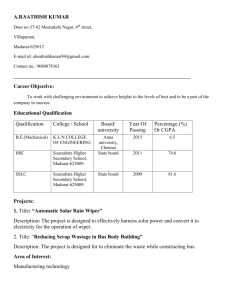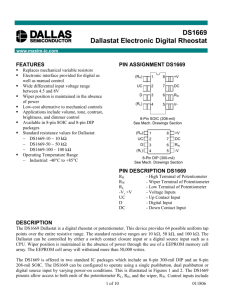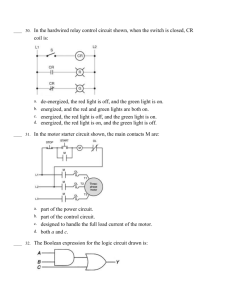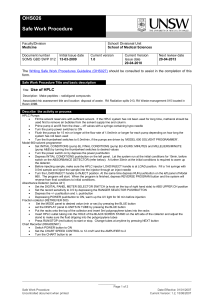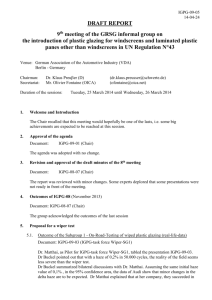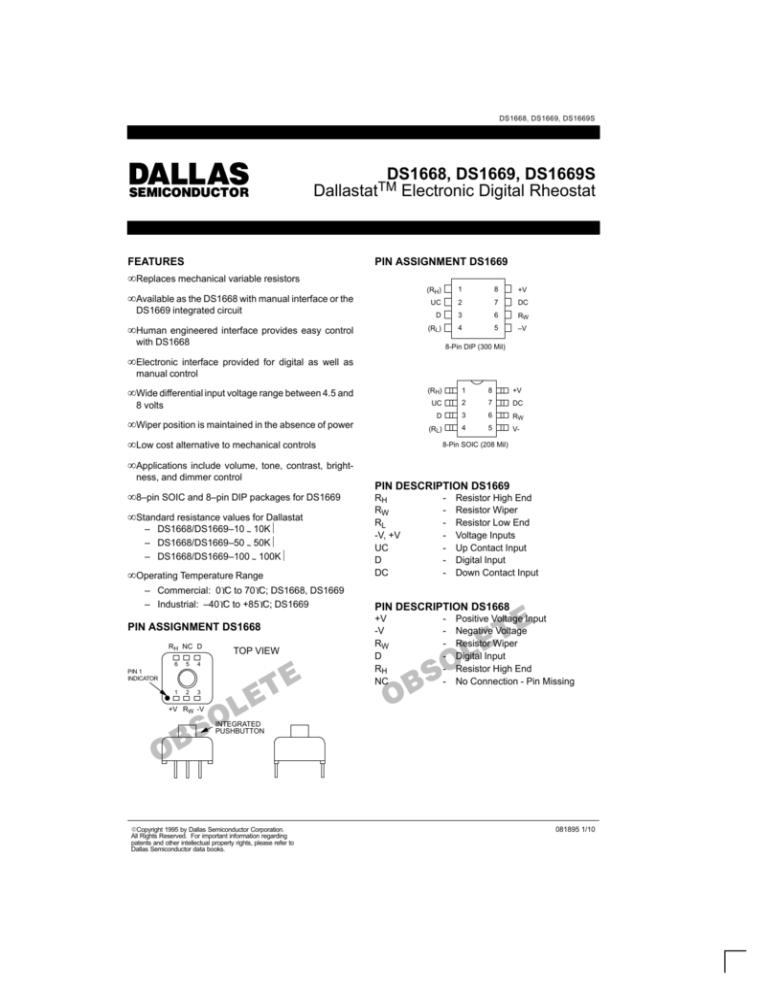
DS1668, DS1669, DS1669S
DS1668, DS1669, DS1669S
DallastatTM Electronic Digital Rheostat
FEATURES
PIN ASSIGNMENT DS1669
• Replaces mechanical variable resistors
• Available as the DS1668 with manual interface or the
DS1669 integrated circuit
• Human
engineered interface provides easy control
with DS1668
(RH)
1
8
+V
UC
2
7
DC
D
3
6
RW
(RL)
4
5
–V
8-Pin DIP (300 Mil)
• Electronic
interface provided for digital as well as
manual control
• Wide differential input voltage range between 4.5 and
8 volts
• Wiper position is maintained in the absence of power
• Low cost alternative to mechanical controls
(RH)
1
8
+V
UC
2
7
DC
D
3
6
RW
(RL)
4
5
V-
8-Pin SOIC (208 Mil)
• Applications
include volume, tone, contrast, brightness, and dimmer control
• 8–pin SOIC and 8–pin DIP packages for DS1669
• Standard resistance values for Dallastat
– DS1668/DS1669–10 ~ 10KΩ
– DS1668/DS1669–50 ~ 50KΩ
– DS1668/DS1669–100 ~ 100KΩ
• Operating Temperature Range
– Commercial: 0°C to 70°C; DS1668, DS1669
– Industrial: –40°C to +85°C; DS1669
PIN ASSIGNMENT DS1668
RH NC D
6
5
4
1
2
3
TOP VIEW
PIN 1
INDICATOR
PIN DESCRIPTION DS1669
RH
RW
RL
-V, +V
UC
D
DC
-
Resistor High End
Resistor Wiper
Resistor Low End
Voltage Inputs
Up Contact Input
Digital Input
Down Contact Input
PIN DESCRIPTION DS1668
+V
-V
RW
D
RH
NC
-
Positive Voltage Input
Negative Voltage
Resistor Wiper
Digital Input
Resistor High End
No Connection - Pin Missing
+V RW -V
INTEGRATED
PUSHBUTTON
Copyright 1995 by Dallas Semiconductor Corporation.
All Rights Reserved. For important information regarding
patents and other intellectual property rights, please refer to
Dallas Semiconductor data books.
081895 1/10
DS1668, DS1669, DS1669S
DESCRIPTION
The DS1668 and DS1669 Dallastats are digital rheostats or potentiometers. These units provide 64 possible uniform tap points over the resistive range and are
available in standard versions of 10K, 50K, and 100K
ohms. The Dallastats can be controlled by either a
mechanical–type contact closure input or a digital
source input such as a CPU. Wiper position is maintained in the absence of power which is accomplished
through the use of a EEPROM memory cell array. The
EEPROM cell array is specified to accept greater than
80,000 writes.
The DS1668 and DS1669 differ in the type packages in
which they are offered. The DS1668 is only available in
a custom 6–pin package with a single integrated pushbutton as shown in the package drawing. The single
integrated pushbutton provides the mechanical control
input of the wiper position. In addition, a digital source
input, D, allows the potentiometer to be controlled by a
microcontroller or processor. Other package pins
include the positive voltage input, +V, the negative voltage input, –V, the resistor wiper terminal, RW, and the
high resistor terminal, RH. The DS1668 is rated for commercial temperature usage only (0°C to 70°C).
The DS1669 is offered in two standard IC packages
which include an 8–pin 300 mil DIP and an 8–pin 200 mil
SOIC. Like the DS1668, the DS1669 can be configured
to operate using a single pushbutton or digital source
input. This is illustrated in Figure 1. Additionally, the
DS1669 can be configured to operate in a dual pushbutton configuration which is shown in Figure 2. The
DS1669 pinouts allow access to both ends of the potentiometer RL, RH, and the wiper, RW. Control inputs
include the digital source input, D, the up contact input,
UC, and the down contact input, DC. Other package
pinouts include the positive,+V, and negative, –V , supply inputs. The DS1669 is available in commercial or
industrial temperature versions.
OPERATION
The DS1668/DS1669 Dallastats are controlled through
a contact closure input or by a digital source input. The
DS1668 is configured to operate from a single contact
closure (pushbutton) input which is integrated in the
custom 6–pin package or the device can be driven from
the digital source input (D). The DS1669 can be controlled using a single pushbutton input, dual pushbutton,
or using the digital source input.
081895 2/10
Figure 3 illustrates the single pushbutton configuration
of the DS1668. Internally, the low end resistor terminal
is connected to the negative supply input terminal. The
integrated pushbutton has one side connected to the
negative supply input while the other side is connected
to the up contact terminal (UC). The digital source input
(D) is accessible through pin 4 of the package. The (D)
input has an internal pull–up resistor and can be allowed
to float when not in use. The down contact input (DC) is
not accessible externally. However, this control input is
internally connected to the positive input supply.
When powered, the DS1668 assumes a single pushbutton mode of operation. Pressure applied to the integrated pushbutton will cause contact closure which in
turn will move the wiper position upward or downward
depending on the previous wiper direction. Single pushbutton mode is accomplished in the same manner for
the DS1669. However, for the DS1669, all connections
must be made by the user since no internal connections
exist (see Figure 1). Note that single pushbutton control
is accomplished when 1) the (DC) input is connected to
the positive supply input and 2) the (D) input is allowed
to float. These two conditions must exist from the time of
device power–up. The UC input controls both upward
and downward movement of the device wiper position in
single pushbutton mode of operation.
Dual pushbutton operation is only available when using
the DS1669. The DS1668, by design, only supports the
single pushbutton mode of operation and digital source
input control. Figure 2 provides a typical application
example of the dual pushbutton configuration for the
DS1669. In dual–pushbutton mode, the up–contact
input (UC) is used solely to provide upward movement
of the wiper position and the down–contact input (DC) is
used to provide downward movement of the wiper position. For dual pushbutton configuration, all control
inputs (UC, DC, and D) must remain open on device
power–up.
The digital source input, D, was designed for microprocessor or controller applications. This control input
manipulates the device in the same manner as the
single pushbutton configuration; controlling movement
of the wiper position in both upward and downward
directions. One added feature over the single pushbutton configuration is the ability to increment or decrement
wiper position at a faster rate. Digital source input control is available regardless of the type of pushbutton
configuration.
DS1668, DS1669, DS1669S
DS1669 SINGLE PUSHBUTTON CONFIGURATION (TYPICAL EXAMPLE) Figure 1
DS1669
RH
V+
UC
DC
D
RW
RL
V–
DS1669 DUAL PUSHBUTTON CONFIGURATION (TYPICAL APPLICATION) Figure 2
DS1669
RH
V+
UC
DC
D
RW
RL
V–
081895 3/10
DS1668, DS1669, DS1669S
Dallastats interpret input pulse widths as the means of
controlling wiper movement. A single pulse width input
over the UC, DC, or D terminals will cause the wiper
position to move 1/64th of the total resistance. All
inputs, UC, DC, or D, are inactive when in the high state.
A transition from a high to low on these inputs is considered the beginning of pulse activity.
A single pulse is defined as being greater than 1 ms but
lasting no longer than a second when using the contact
closure inputs UC and DC. When using the D input a
single pulse is defined as being greater than 1 µs but
lasting no longer than 1 second. This is shown in Figures 4a and 6a. Repetitive pulsed inputs can be used to
step through each resistive position of the device (see
Figures 4a and 6b). The requirement for repetitive
pulsed inputs is that pulses must be separated by a
minimum time of 1 ms. If not, the Dallastat will interpret
repetitive pulses as a single continuous pulse.
Pulse inputs lasting longer than 1 second will cause the
wiper to move one position every 100 ms following the
initial 1 second hold time. The total time to transcend the
entire potentiometer using a continuous input pulse is
given in the equation below:
1 (second) + 63 X 100 ms = 7.3 (seconds)
In single pushbutton mode or when using the digital
source input, as the wiper reaches the end of the potentiometer its direction of movement reverses. This will
occur whether or not the input is a continuous pulse or a
sequence of repetitive pulses. Changing the direction of
wiper movement in single pushbutton mode or digital
source mode is also accomplished by a period of inactivity on the UC or D inputs for (minimum) 1 second or
greater. In dual pushbutton mode, the direction is controlled by the UC and DC inputs. No wait states are
required to change wiper direction in dual pushbutton
mode. Additionally, in dual pushbutton mode as the
wiper reaches the end of the potentiometer, the direction of wiper movement will not change. Wiper position
will remain at the potentiometers’ end until an opposite
direction input is given.
All control inputs, UC, DC, and D, are internally pulled
up with a 100K ohm resistance. Additionally, the UC and
DC inputs are internally debounced and require no
external components for input signal conditioning.
The DS1668/DS1669 are provided with two supply
inputs –V and +V. The maximum voltage difference
081895 4/10
between the two supply inputs is + 8.0 volts while the
minimum voltage difference is +4.5 volts. All input levels
are referenced to the negative supply input, –V. The voltage applied to any Dallastat terminal must not exceed the
negative supply voltage (–V ) by –0.5 or the positive supply voltage (+V) by + 0.5 volts. The minimum logic high
level must be +2.4 volts with reference to the –V supply
voltage input. A logic low level with reference to the –V
supply voltage has a maximum value of +0.8 volts. Dallastats exhibit a typical wiper resistance of 400 ohms with
a maximum wiper resistance of 1000 ohms. The maximum wiper current allowed through the Dallastat is specified at 1 milliamps (see DC Electrical Characteristics).
NONVOLATILE WIPER SETTINGS
Dallastats maintain the position of the wiper in the
absence of power. This feature is provided through the
use of EEPROM type memory cell arrays. During normal operation the position of the wiper is determined by
the input multiplexer. Periodically, the multiplexer will
update the EEPROM memory cells. The manner in
which an update occurs has been optimized for reliability, durability, and performance. Additionally, the update
operation is totally transparent to the user.
When power is applied to the Dallastat, the wiper setting
will be the last recorded in the EEPROM memory cells.
If the Dallastat setting is changed after power is applied,
the new value will be stored after a delay of 2 seconds.
The initial storage of a new value after power–up,
occurs when the first change is made, regardless of
when this change is made.
After the initial change on power–up, subsequent
changes in the Dallastat EEPROM memory cells will
occur only if the wiper position of the part is moved
greater than 12.5% of the total resistance range. Any
wiper movement after initial power–up which is less
than 12.5% will not be recorded in the EEPROM
memory cells. Since the Dallastat contains a 64–to–1
multiplexer, a change of greater than 12.5% corresponds to a change of the fourth LSB.
Changes or storage to the EEPROM memory cells must
allow for a 2 second delay to guarantee that updates will
occur. The EEPROM memory cells are specified to
accept greater than 80,000 writes before a wear–out
condition. If the EEPROM memory cells do reach a
wear–out condition, the Dallastat will still function properly while power is applied. However, on power–up the
device’s wiper position will be that of the position last
recorded before memory cell wear out.
DS1668, DS1669, DS1669S
DS1668 DALLASTATTM BLOCK DIAGRAM Figure 3
+
INPUT
INTERPRETER
AND CONTROL
D
UC
DC
RL
SHADOW MEMORY
64 TO 1 MUXER
RH
RHEOSTAT
NOTE:
RW
DOTTED LINE CONNECTIONS AND
COMPONENTS ARE INTERNAL TO
THE DS1668 AND DO NOT EXIST ON
THE DS1669.
FLOWCHART: ONE BUTTON OPERATION AND ELECTRICAL CONTROL Figure 4
CONTACT CLOSURE
(D OR UC)
INCREMENT/DECREMENT
1/64TH
NO
CONTACT CLOSED
CONTINUOUSLY
> 1 SEC ?
NO
LIMIT REACHED
OR
CONTACT OPEN
1 SEC ?
YES
REVERSE DIRECTION
YES
INCREMENT/DECREMENT
ON 100MS INTERVALS
CONTACT OPEN AND CONTACT CLOSURE TIMING IS 1s ± 10%
081895 5/10
DS1668, DS1669, DS1669S
FLOWCHART: TWO BUTTON OPERATION Figure 5
CONTACT CLOSURE
UC
UC OR DC?
DC
YES
AT UPPER
LIMIT?
YES
BOTH CONTACTS
OPEN?
YES
NO
NO
INCREMENT
1/64TH
CONTACT CLOSED
CONTINUOUSLY
>1 SEC?
DECREMENT
1/64TH
NO
NO
DECREMENT ON
100MS INTERVALS
INCREMENT ON
100MS INTERVALS
AT UPPER
LIMIT?
YES
YES
CONTACT OPEN AND CONTACT CLOSURE TIMING IS 1 sec. ± 10%
081895 6/10
CONTACT CLOSED
CONTINUOUSLY
>1 SEC?
YES
YES
NO
AT LOWER
LIMIT?
AT LOWER
LIMIT?
NO
DS1668, DS1669, DS1669S
ABSOLUTE MAXIMUM RATINGS*
Voltage on Any Pin Relative to -V
Operating Temperature
Storage Temperature
Soldering Temperature
-V –0.5V + 8.0V
0°C to 70°C commercial; –40°C to +85°C industrial
–55°C to +125°C
260°C for 15 seconds
* This is a stress rating only and functional operation of the device at these or any other conditions above those
indicated in the operation sections of this specification is not implied. Exposure to absolute maximum rating
conditions for extended periods of time may affect reliability.
RECOMMENDED DC OPERATING CONDITIONS
PARAMETER
SYMBOL
MIN
+ Supply Voltage
+V
- Supply Voltage
Rheostat Inputs
(-40°C to +85°C)
MAX
UNITS
-V + 4.5
-V + 8.0
V
-V
+V - 8.0
+V - 4.5
V
RH,RW,RL
-V - 0.5
+V + 0.5
V
Logic Input 1
VIH
+2.4
Logic Input 0
VIL
+0.8
DC ELECTRICAL CHARACTERISTICS
PARAMETER
SYMBOL
TYP
NOTES
V
1, 2
V
1, 2
(-40°C to +85°C; -V to +V = 4.5V to 8.0V)
MIN
TYP
MAX
UNITS
NOTES
1
2
mA
3
65
µA
9
+, - Supply Current
ICC1
Supply Current, Idle State
ICC2
Wiper Resistance
RW
1000
Ω
Wiper Current
IW
1
mA
5
Rheostat Current
IH, IL
1
mA
5
Power–Up Time
tPU
10
µs
10
Input Leakage
ILI
+1
µA
1
400
–1
AC ELECTRICAL CHARACTERISTICS
PARAMETER
(-40°C to +85°C; -V to+V = 4.5V to 8.0V)
SYMBOL
MIN
Digital Input Pulse Width
tDPW
Contact Pulse Width
TYP
MAX
UNITS
NOTES
1
DC
µs
1, 7, 8
tCPW
1
DC
ms
1, 7, 8
Repetitive Input Pulse High Time
tHPW
1
DC
ms
1, 7, 8
Continuous Input Pulse
tCCP
1
DC
s
1, 7, 8
081895 7/10
DS1668, DS1669, DS1669S
ANALOG RESISTOR CHARACTERISTICS
PARAMETER
SYMBOL
(-40°C to +85°C)
MAX
UNITS
–20
+20
%
Absolute Linearity
–0.75
+0.75
LSB
11
Relative Linearity
–0.3
+0.3
LSB
12
Hz
13
End–to–End Resistor Tolerance
–3 dB Cutoff Frequency Noise
Figure
MIN
TYP
fcutoff
Temperature Coefficient
–800
+800
ppm/C
MAX
UNITS
NOTES
CIN
5
pF
6
COUT
7
pF
6
CAPACITANCE
PARAMETER
Input Capacitance
Output Capacitance
(tA=25°C)
SYMBOL
MIN
TYP
TIMING DIAGRAMS Figure 6
(A) SINGLE PULSE INPUTS
tCPW
tDPW
VIH
VIL
(B) REPETITIVE PULSE INPUTS
tCPW
tDPW
tHPW
VIH
VIL
(C) CONTINUOUS PULSE INPUTS
tCCP
VIH
VIL
081895 8/10
NOTES
DS1668, DS1669, DS1669S
NOTES:
1. All inputs; UV, DC, and D are internally pulled up with a resistance of 100KΩ.
2. Input logic levels are referenced to -V.
3. ICC is the internal current that flows between -V and +V.
4. Input leakage applies to contact inputs UC and DC and digital input (D).
5. Wiper current and rheostat currents are the maximum current which can flow in the resistive elements.
6. Capacitance values apply at 25°C.
7. Input pulse width is the minimum time required for an input to cause an increment or decrement. If the UC,
DC or D input is held active for longer than 1 second, subsequent increments or decrements will occur on 100
ms intervals until the inputs UC, DC, and/or D is released to VIH.
8. Repetitive pulsed inputs on UC, DC, or D will be recognized as long as the pulse repetition occurs within 1
second of each other. Pulses occurring faster than 1 ms apart may not be recognized as individual inputs but
can be interpreted a constant input.
9. Idle state supply current is measured with no pushbutton depressed and with the wiper. RW tied to a CMOS
load.
10. Maximum time required for the Dallastat to determine single or dual push button operation after input supply
has reached 10% recommended supply operating conditions.
11. Aboslute linearity is used to determine wiper voltage versus expected voltage as determined by wiper position.
12. Relative linearity is used to determine the change in voltage between successive tap positions.
13. –3 dB cutoff frequency characteristics for the DS1669 depend on potentiometer total resistance:
DS1669–010; 1 MHz, DS1669–050; 200 KHz, DS1669–100; 100 KHz.
081895 9/10
DS1668, DS1669, DS1669S
DS1668 PUSHBUTTON DIMENSIONS
.420
PIN 1
INDICATOR
.420
.185
.100
.185
.035
.125
.022
.012
.100
.300
081895 10/10

